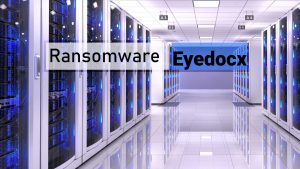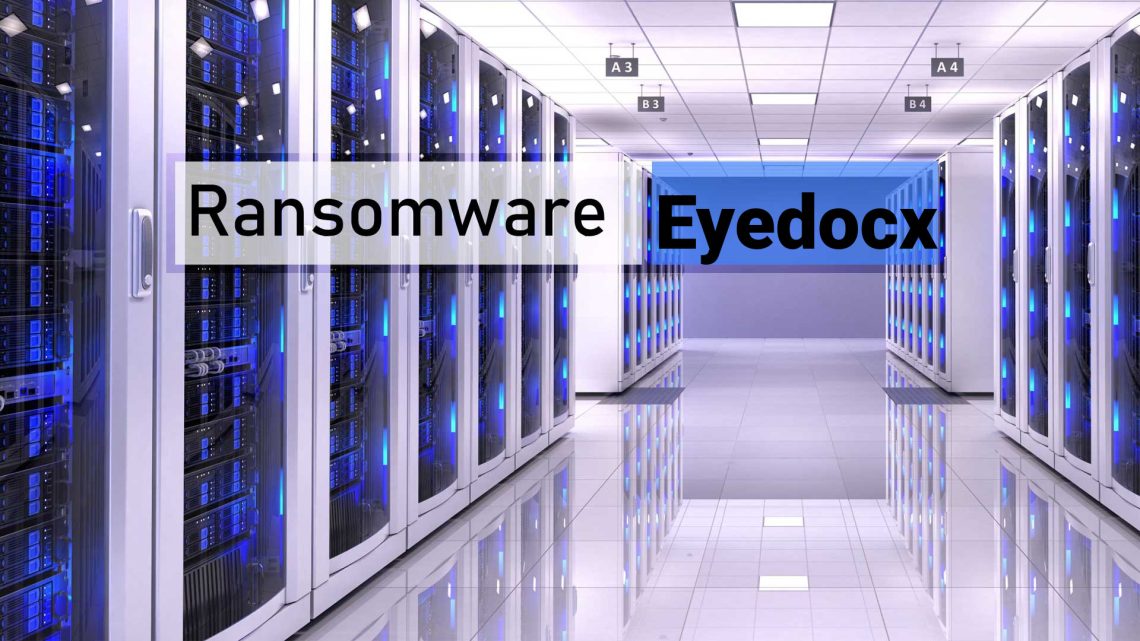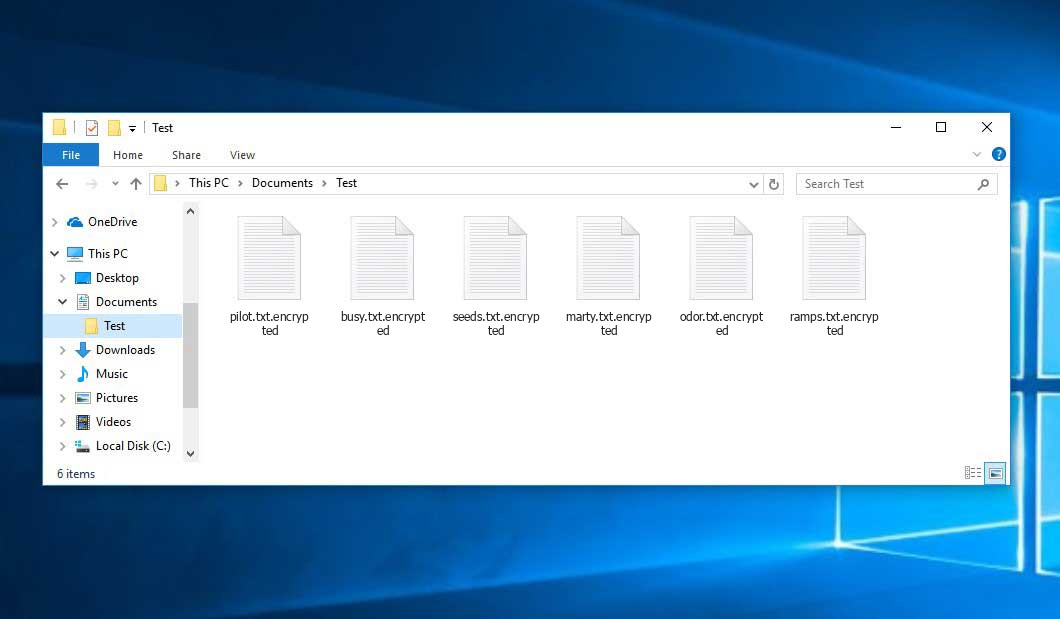The Eyedocx virus falls within the ransomware type of malicious agent. Ransomware of this type encrypts all user’s data on the computer (photos, documents, excel sheets, audio files, videos, etc) and appends its extra extension to every file, creating the readme.information.txt text files in every directory which contains the encrypted files.
What is known about the Eyedocxvirus?
☝️ A strictly correct denomination for the Eyedocx would be “a ransomware infection”.
Eyedocx adds its extra .encrypted extension to every file’s name. For instance, a file named “photo.jpg” will be changed to “photo.jpg.encrypted”. In the same manner, the Excel file with the name “table.xlsx” will end up as “table.xlsx.encrypted”, and so on.
In each folder with the encoded files, a readme.information.txt file will appear. It is a ransom money note. Therein you can find information on the ways of contacting the racketeers and some other remarks. The ransom note usually contains a description of how to purchase the decryption tool from the ransomware developers. That is pretty much the scheme of the malefaction.
Eyedocx abstract:
| Name | Eyedocx Virus |
| Extension | .encrypted |
| Ransomware note | readme.information.txt |
| Detection | Win32:Vitro [Inf], Backdoor:ASP/Chopper.F!dha, Ransom:Win32/Multiverze |
| Symptoms | Your files (photos, videos, documents) have a .encrypted extension and you can’t open them. |
| Fix Tool | See If Your System Has Been Affected by Eyedocx virus |
In the screenshot below, you can see what a directory with files encrypted by the Eyedocx looks like. Each filename has the “.encrypted” extension appended to it.
How did my machine catch Eyedocx ransomware?
There is a huge number of possible ways of ransomware injection.
Nowadays, there are three most popular methods for evil-doers to have the Eyedocx virus acting in your system. These are email spam, Trojan introduction and peer-to-peer file transfer.
If you access your inbox and see letters that look like familiar notifications from utility services providers, delivery agencies like FedEx, web-access providers, and whatnot, but whose addresser is unknown to you, beware of opening those letters. They are very likely to have a malicious item attached to them. Thus it is even more dangerous to download any attachments that come with letters like these.
Another thing the hackers might try is a Trojan horse scheme1. A Trojan is an object that infiltrates into your machine pretending to be something legal. For example, you download an installer for some program you want or an update for some service. However, what is unboxed turns out to be a harmful agent that encodes your data. As the installation wizard can have any name and any icon, you’d better be sure that you can trust the resource of the things you’re downloading. The optimal way is to use the software developers’ official websites.
As for the peer-to-peer networks like torrents or eMule, the threat is that they are even more trust-based than the rest of the Internet. You can never guess what you download until you get it. So you’d better be using trustworthy resources. Also, it is a good idea to scan the directory containing the downloaded items with the anti-malware utility as soon as the downloading is finished.
How to remove the Eyedocx virus?
It is crucial to inform you that besides encrypting your files, the Eyedocx virus will most likely deploy the Azorult Spyware on your computer to get access to credentials to various accounts (including cryptocurrency wallets). That spyware2 can extract your logins and passwords from your browser’s auto-filling data.
Often tamperers would decode few of your files to prove that they do have the decryption tool. As Eyedocx virus is a relatively recent ransomware, safety measures engineers have not yet found a method to reverse its work. Nevertheless, the decoding instruments are frequently updated, so the effective countermeasure may soon arrive.
Understandably, if the criminals do the job of encoding someone’s essential data, the desperate person will probably comply with their demands. However, paying to racketeers gives no guarantee that you’re getting your data back. It is still dangerous. After getting the money, the racketeers may send a wrong decryption key to the injured party. There were reports about criminals just vanishing after getting the ransom without even bothering to reply.
The optimal solution against ransomware is to have a system restore point or the copies of your critical files in the cloud disk or at least on an external drive. Obviously, that might be not enough. Your most crucial thing could be that one you were working upon when it all happened. But at least it is something. It is also wise to scan your drives with the antivirus program after the system is rolled back.
Eyedocx is not the only ransomware of its kind, since there are other specimens of ransomware out there that act in the same manner. For instance, Tury, Powd, Bowd, and some others. The two main differences between them and the Eyedocx are the ransom amount and the method of encryption. The rest is almost identical: files become inaccessible, their extensions changed, ransom notes appear in each folder containing encoded files.
Some lucky victims were able to decode the arrested files with the aid of the free tools provided by anti-malware specialists. Sometimes the racketeers accidentally send the decoding code to the wronged in the ransom readme. Such an extraordinary fail allows the user to restore the files. But naturally, one should never expect such a chance. Remember, ransomware is a tamperers’ tool to pull the money out of their victims.
How to avert ransomware infection?
Eyedocx ransomware has no endless power, so as any similar malware.
You can defend yourself from ransomware infiltration within three easy steps:
- Never open any letters from unknown senders with strange addresses, or with content that has nothing to do with something you are waiting for (how can you win in a lottery without even taking part in it?). In case the email subject is likely something you are expecting, check all elements of the dubious letter carefully. A fake letter will surely have a mistake.
- Do not use cracked or untrusted software. Trojans are often shared as a part of cracked software, possibly under the guise of “patch” preventing the license check. But potentially dangerous programs are very hard to tell from trustworthy ones, as trojans may also have the functionality you need. Try searching for information on this software product on the anti-malware message boards, but the best solution is not to use such software.
- And to be sure about the safety of the files you downloaded, check them with GridinSoft Anti-Malware. This software will be a perfect shield for your personal computer.
Reasons why I would recommend GridinSoft3
There is no better way to recognize, remove and prevent ransomware than to use an anti-malware software from GridinSoft4.
Download Removal Tool.
You can download GridinSoft Anti-Malware by clicking the button below:
Run the setup file.
When setup file has finished downloading, double-click on the setup-antimalware-fix.exe file to install GridinSoft Anti-Malware on your system.

An User Account Control asking you about to allow GridinSoft Anti-Malware to make changes to your device. So, you should click “Yes” to continue with the installation.

Press “Install” button.

Once installed, Anti-Malware will automatically run.

Wait for the Anti-Malware scan to complete.
GridinSoft Anti-Malware will automatically start scanning your PC for Eyedocx infections and other malicious programs. This process can take a 20-30 minutes, so I suggest you periodically check on the status of the scan process.

Click on “Clean Now”.
When the scan has finished, you will see the list of infections that GridinSoft Anti-Malware has detected. To remove them click on the “Clean Now” button in right corner.

Frequently Asked Questions
🤔 How can I open “.encrypted” files?Can I somehow access “.encrypted” files?
Negative. That is why ransomware is so frustrating. Until you decode the “.encrypted” files you will not be able to access them.
🤔 I really need to decrypt those “.encrypted” files ASAP. How can I do that?
It’s good if you have fаr-sightedly saved copies of these important files elsewhere. If not, there is still a function of System Restore but it needs a Restore Point to be previously saved. All other solutions require time.
🤔 If GridinSoft deletes the Eyedocx malware, will it also delete my files that were encrypted?
No way! Your encrypted files are no threat to your PC.
GridinSoft Anti-Malware only deals with active threats. The virus that has attacked your computer is must be still functional and running scans from time to time to arrest any new files you might create on your PC after the infection. As it has already been said, the Eyedocx virus does not come alone. It installs backdoors and keyloggers that can steal your account credentials and provide malefactors with easy access to your system in the future.
🤔 What actions should I take if the Eyedocx virus has blocked my PC and I can’t get the activation key.
In such an unfortunate situation, you need to prepare a flash memory card with a previously installed Trojan Killer. Use Safe Mode to do the cleaning. You see, the ransomware starts automatically as the system boots and encrypts any new files created or brought into your machine. To suppress this function – use Safe Mode, which allows only the vital programs to run automatically. Consider reading our manual on booting Windows in Safe Mode.
🤔 What could help the situation right now?
Many of the encoded files might still be within your reach
- If you exchanged your important files through email, you could still download them from your online mail server.
- You may have shared photographs or videos with your friends or relatives. Just ask them to send those images back to you.
- If you have initially got any of your files from the Web, you can try downloading them again.
- Your messengers, social media pages, and cloud disks might have all those files too.
- Maybe you still have the needed files on your old computer, a portable device, cellphone, external storage, etc.
HINT: You can employ file recovery programs5 to retrieve your lost information since ransomware encodes the copies of your files, removing the authentic ones. In the tutorial below, you can learn how to recover your files with PhotoRec, but remember: you can do it only after you remove the virus with an antivirus program.
Also, you can contact the following governmental fraud and scam sites to report this attack:
- In the United States: On Guard Online;
- In Canada: Canadian Anti-Fraud Centre;
- In the United Kingdom: Action Fraud;
- In Australia: SCAMwatch;
- In New Zealand: Consumer Affairs Scams;
- In France: Agence nationale de la sécurité des systèmes d’information;
- In Germany: Bundesamt für Sicherheit in der Informationstechnik;
- In Ireland: An Garda Síochána;
To report the attack, you can contact local executive boards. For instance, if you live in USA, you can have a talk with FBI Local field office, IC3 or Secret Service.
I need your help to share this article.
It is your turn to help other people. I have written this guide to help people like you. You can use the buttons below to share this on your favorite social media Facebook, Twitter, or Reddit.
Brendan SmithHow to Remove EYEDOCX Ransomware & Recover PC

Name: EYEDOCX Virus
Description: EYEDOCX Virus is a ransomware-type infections. This virus encrypts important personal files (video, photos, documents). The encrypted files can be tracked by a specific .encrypted extension. So, you can't use them at all.
Operating System: Windows
Application Category: Virus
User Review
( votes)References
- You can read more on Trojans, their use and types in the Trojan-dedicated section of GridinSoft official website.
- You can read more on spyware variants and nature in the respective section of GridinSoft official website.
- GridinSoft Anti-Malware Review from HowToFix site: https://howtofix.guide/gridinsoft-anti-malware/
- More information about GridinSoft products: https://gridinsoft.com/comparison
- Here’s the list of Best Data Recovery Software Of 2023.



